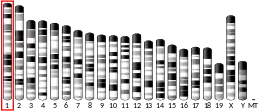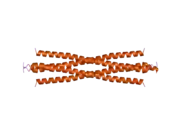HDAC4
Histone deacetylase 4, also known as HDAC4, is a protein that in humans is encoded by the HDAC4 gene.[5][6]
Function
Histones play a critical role in transcriptional regulation, cell cycle progression, and developmental events. Histone acetylation/deacetylation alters chromosome structure and affects transcription factor access to DNA. The protein encoded by this gene belongs to class II of the histone deacetylase/acuc/apha family. It possesses histone deacetylase activity and represses transcription when tethered to a promoter. This protein does not bind DNA directly but through transcription factors MEF2C and MEF2D. It seems to interact in a multiprotein complex with RbAp48 and HDAC3.[7] Furthermore, HDAC4 is required for TGFbeta1-induced myofibroblastic differentiation.[8]
Clinical significance
Studies have shown that HDAC4 regulates bone and muscle development. Harvard University researchers also concluded that it promotes healthy vision: Reduced levels of the protein led to the death of the rod photoreceptors and bipolar cells in the retinas of mice.[9][10]
Interactions
HDAC4 has been shown to interact with:
- BCL6,[11]
- BTG2,[12][13]
- CBX5,[14]
- GATA1,[15]
- HDAC3,[5][16][17][18]
- MAPK1,[19]
- MAPK3,[19]
- MEF2C,[20][21]
- Myocyte-specific enhancer factor 2A,[22][23]
- Nuclear receptor co-repressor 1,[16][24]
- Nuclear receptor co-repressor 2,[16][24]
- Testicular receptor 2,[25][26]
- YWHAB,[17]
- YWHAE,[17][27] and
- Zinc finger and BTB domain-containing protein 16.[11][28]
See also
References
- GRCh38: Ensembl release 89: ENSG00000068024 - Ensembl, May 2017
- GRCm38: Ensembl release 89: ENSMUSG00000026313 - Ensembl, May 2017
- "Human PubMed Reference:". National Center for Biotechnology Information, U.S. National Library of Medicine.
- "Mouse PubMed Reference:". National Center for Biotechnology Information, U.S. National Library of Medicine.
- Grozinger CM, Hassig CA, Schreiber SL (April 1999). "Three proteins define a class of human histone deacetylases related to yeast Hda1p". Proceedings of the National Academy of Sciences of the United States of America. 96 (9): 4868–73. Bibcode:1999PNAS...96.4868G. doi:10.1073/pnas.96.9.4868. PMC 21783. PMID 10220385.
- Fischle W, Emiliani S, Hendzel MJ, Nagase T, Nomura N, Voelter W, Verdin E (April 1999). "A new family of human histone deacetylases related to Saccharomyces cerevisiae HDA1p". The Journal of Biological Chemistry. 274 (17): 11713–20. doi:10.1074/jbc.274.17.11713. PMID 10206986.
- "Entrez Gene: HDAC4 histone deacetylase 4".
- Glenisson W, Castronovo V, Waltregny D (October 2007). "Histone deacetylase 4 is required for TGFbeta1-induced myofibroblastic differentiation". Biochimica et Biophysica Acta (BBA) - Molecular Cell Research. 1773 (10): 1572–82. doi:10.1016/j.bbamcr.2007.05.016. PMID 17610967.
- Protein for Sight, Scientific American, 300, 3 (March 2009), p. 23
- Chen B, Cepko CL (January 2009). "HDAC4 regulates neuronal survival in normal and diseased retinas". Science. 323 (5911): 256–9. doi:10.1126/science.1166226. PMC 3339762. PMID 19131628.
- Lemercier C, Brocard MP, Puvion-Dutilleul F, Kao HY, Albagli O, Khochbin S (June 2002). "Class II histone deacetylases are directly recruited by BCL6 transcriptional repressor". The Journal of Biological Chemistry. 277 (24): 22045–52. doi:10.1074/jbc.M201736200. PMID 11929873.
- Farioli-Vecchioli S, Tanori M, Micheli L, Mancuso M, Leonardi L, Saran A, Ciotti MT, Ferretti E, Gulino A, Pazzaglia S, Tirone F (July 2007). "Inhibition of medulloblastoma tumorigenesis by the antiproliferative and pro-differentiative gene PC3". FASEB Journal. 21 (9): 2215–25. doi:10.1096/fj.06-7548com. PMID 17371797. S2CID 4974360.
- Micheli L, D'Andrea G, Leonardi L, Tirone F (July 2017). "HDAC1, HDAC4, and HDAC9 Bind to PC3/Tis21/Btg2 and Are Required for Its Inhibition of Cell Cycle Progression and Cyclin D1 Expression" (PDF). Journal of Cellular Physiology. 232 (7): 1696–1707. doi:10.1002/jcp.25467. PMID 27333946. S2CID 4070837.
- Zhang CL, McKinsey TA, Olson EN (October 2002). "Association of class II histone deacetylases with heterochromatin protein 1: potential role for histone methylation in control of muscle differentiation". Molecular and Cellular Biology. 22 (20): 7302–12. doi:10.1128/mcb.22.20.7302-7312.2002. PMC 139799. PMID 12242305.
- Watamoto K, Towatari M, Ozawa Y, Miyata Y, Okamoto M, Abe A, Naoe T, Saito H (December 2003). "Altered interaction of HDAC5 with GATA-1 during MEL cell differentiation". Oncogene. 22 (57): 9176–84. doi:10.1038/sj.onc.1206902. PMID 14668799.
- Fischle W, Dequiedt F, Hendzel MJ, Guenther MG, Lazar MA, Voelter W, Verdin E (January 2002). "Enzymatic activity associated with class II HDACs is dependent on a multiprotein complex containing HDAC3 and SMRT/N-CoR". Molecular Cell. 9 (1): 45–57. doi:10.1016/s1097-2765(01)00429-4. hdl:11858/00-001M-0000-002C-9FF9-9. PMID 11804585.
- Grozinger CM, Schreiber SL (July 2000). "Regulation of histone deacetylase 4 and 5 and transcriptional activity by 14-3-3-dependent cellular localization". Proceedings of the National Academy of Sciences of the United States of America. 97 (14): 7835–40. Bibcode:2000PNAS...97.7835G. doi:10.1073/pnas.140199597. PMC 16631. PMID 10869435.
- Fischle W, Dequiedt F, Fillion M, Hendzel MJ, Voelter W, Verdin E (September 2001). "Human HDAC7 histone deacetylase activity is associated with HDAC3 in vivo". The Journal of Biological Chemistry. 276 (38): 35826–35. doi:10.1074/jbc.M104935200. PMID 11466315.
- Zhou X, Richon VM, Wang AH, Yang XJ, Rifkind RA, Marks PA (December 2000). "Histone deacetylase 4 associates with extracellular signal-regulated kinases 1 and 2, and its cellular localization is regulated by oncogenic Ras". Proceedings of the National Academy of Sciences of the United States of America. 97 (26): 14329–33. Bibcode:2000PNAS...9714329Z. doi:10.1073/pnas.250494697. PMC 18918. PMID 11114188.
- Wang AH, Bertos NR, Vezmar M, Pelletier N, Crosato M, Heng HH, Th'ng J, Han J, Yang XJ (November 1999). "HDAC4, a human histone deacetylase related to yeast HDA1, is a transcriptional corepressor". Molecular and Cellular Biology. 19 (11): 7816–27. doi:10.1128/mcb.19.11.7816. PMC 84849. PMID 10523670.
- Wang AH, Yang XJ (September 2001). "Histone deacetylase 4 possesses intrinsic nuclear import and export signals". Molecular and Cellular Biology. 21 (17): 5992–6005. doi:10.1128/mcb.21.17.5992-6005.2001. PMC 87317. PMID 11486037.
- Miska EA, Karlsson C, Langley E, Nielsen SJ, Pines J, Kouzarides T (September 1999). "HDAC4 deacetylase associates with and represses the MEF2 transcription factor". The EMBO Journal. 18 (18): 5099–107. doi:10.1093/emboj/18.18.5099. PMC 1171580. PMID 10487761.
- Lemercier C, Verdel A, Galloo B, Curtet S, Brocard MP, Khochbin S (May 2000). "mHDA1/HDAC5 histone deacetylase interacts with and represses MEF2A transcriptional activity" (PDF). The Journal of Biological Chemistry. 275 (20): 15594–9. doi:10.1074/jbc.M908437199. PMID 10748098. S2CID 39220205.
- Huang EY, Zhang J, Miska EA, Guenther MG, Kouzarides T, Lazar MA (January 2000). "Nuclear receptor corepressors partner with class II histone deacetylases in a Sin3-independent repression pathway". Genes & Development. 14 (1): 45–54. PMC 316335. PMID 10640275.
- Franco PJ, Li G, Wei LN (August 2003). "Interaction of nuclear receptor zinc finger DNA binding domains with histone deacetylase". Molecular and Cellular Endocrinology. 206 (1–2): 1–12. doi:10.1016/s0303-7207(03)00254-5. PMID 12943985. S2CID 19487189.
- Franco PJ, Farooqui M, Seto E, Wei LN (August 2001). "The orphan nuclear receptor TR2 interacts directly with both class I and class II histone deacetylases". Molecular Endocrinology. 15 (8): 1318–28. doi:10.1210/mend.15.8.0682. PMID 11463856.
- Miska EA, Langley E, Wolf D, Karlsson C, Pines J, Kouzarides T (August 2001). "Differential localization of HDAC4 orchestrates muscle differentiation". Nucleic Acids Research. 29 (16): 3439–47. doi:10.1093/nar/29.16.3439. PMC 55849. PMID 11504882.
- Chauchereau A, Mathieu M, de Saintignon J, Ferreira R, Pritchard LL, Mishal Z, Dejean A, Harel-Bellan A (November 2004). "HDAC4 mediates transcriptional repression by the acute promyelocytic leukaemia-associated protein PLZF". Oncogene. 23 (54): 8777–84. doi:10.1038/sj.onc.1208128. PMID 15467736.
Further reading
- Pazin MJ, Kadonaga JT (May 1997). "What's up and down with histone deacetylation and transcription?". Cell. 89 (3): 325–8. doi:10.1016/S0092-8674(00)80211-1. PMID 9150131. S2CID 11488594.
- Verdin E, Dequiedt F, Kasler HG (May 2003). "Class II histone deacetylases: versatile regulators". Trends in Genetics. 19 (5): 286–93. doi:10.1016/S0168-9525(03)00073-8. PMID 12711221.
- Andersson B, Wentland MA, Ricafrente JY, Liu W, Gibbs RA (April 1996). "A "double adaptor" method for improved shotgun library construction". Analytical Biochemistry. 236 (1): 107–13. doi:10.1006/abio.1996.0138. PMID 8619474.
- Yu W, Andersson B, Worley KC, Muzny DM, Ding Y, Liu W, Ricafrente JY, Wentland MA, Lennon G, Gibbs RA (April 1997). "Large-scale concatenation cDNA sequencing". Genome Research. 7 (4): 353–8. doi:10.1101/gr.7.4.353. PMC 139146. PMID 9110174.
- Wolffe AP (May 1997). "Transcriptional control. Sinful repression". Nature. 387 (6628): 16–7. doi:10.1038/387016a0. PMID 9139815. S2CID 29803420.
- Ohara O, Nagase T, Ishikawa K, Nakajima D, Ohira M, Seki N, Nomura N (February 1997). "Construction and characterization of human brain cDNA libraries suitable for analysis of cDNA clones encoding relatively large proteins". DNA Research. 4 (1): 53–9. doi:10.1093/dnares/4.1.53. PMID 9179496.
- Fischle W, Emiliani S, Hendzel MJ, Nagase T, Nomura N, Voelter W, Verdin E (April 1999). "A new family of human histone deacetylases related to Saccharomyces cerevisiae HDA1p". The Journal of Biological Chemistry. 274 (17): 11713–20. doi:10.1074/jbc.274.17.11713. PMID 10206986.
- Grozinger CM, Hassig CA, Schreiber SL (April 1999). "Three proteins define a class of human histone deacetylases related to yeast Hda1p". Proceedings of the National Academy of Sciences of the United States of America. 96 (9): 4868–73. Bibcode:1999PNAS...96.4868G. doi:10.1073/pnas.96.9.4868. PMC 21783. PMID 10220385.
- Miska EA, Karlsson C, Langley E, Nielsen SJ, Pines J, Kouzarides T (September 1999). "HDAC4 deacetylase associates with and represses the MEF2 transcription factor". The EMBO Journal. 18 (18): 5099–107. doi:10.1093/emboj/18.18.5099. PMC 1171580. PMID 10487761.
- Wang AH, Bertos NR, Vezmar M, Pelletier N, Crosato M, Heng HH, Th'ng J, Han J, Yang XJ (November 1999). "HDAC4, a human histone deacetylase related to yeast HDA1, is a transcriptional corepressor". Molecular and Cellular Biology. 19 (11): 7816–27. doi:10.1128/mcb.19.11.7816. PMC 84849. PMID 10523670.
- Youn HD, Grozinger CM, Liu JO (July 2000). "Calcium regulates transcriptional repression of myocyte enhancer factor 2 by histone deacetylase 4". The Journal of Biological Chemistry. 275 (29): 22563–7. doi:10.1074/jbc.C000304200. PMID 10825153.
- Grozinger CM, Schreiber SL (July 2000). "Regulation of histone deacetylase 4 and 5 and transcriptional activity by 14-3-3-dependent cellular localization". Proceedings of the National Academy of Sciences of the United States of America. 97 (14): 7835–40. Bibcode:2000PNAS...97.7835G. doi:10.1073/pnas.140199597. PMC 16631. PMID 10869435.
- Huynh KD, Fischle W, Verdin E, Bardwell VJ (July 2000). "BCoR, a novel corepressor involved in BCL-6 repression". Genes & Development. 14 (14): 1810–23. doi:10.1101/gad.14.14.1810 (inactive 2021-01-14). PMC 316791. PMID 10898795.CS1 maint: DOI inactive as of January 2021 (link)
- Li J, Wang J, Wang J, Nawaz Z, Liu JM, Qin J, Wong J (August 2000). "Both corepressor proteins SMRT and N-CoR exist in large protein complexes containing HDAC3". The EMBO Journal. 19 (16): 4342–50. doi:10.1093/emboj/19.16.4342. PMC 302030. PMID 10944117.
- Wang AH, Kruhlak MJ, Wu J, Bertos NR, Vezmar M, Posner BI, Bazett-Jones DP, Yang XJ (September 2000). "Regulation of histone deacetylase 4 by binding of 14-3-3 proteins". Molecular and Cellular Biology. 20 (18): 6904–12. doi:10.1128/MCB.20.18.6904-6912.2000. PMC 88766. PMID 10958686.
- Zhang CL, McKinsey TA, Lu JR, Olson EN (January 2001). "Association of COOH-terminal-binding protein (CtBP) and MEF2-interacting transcription repressor (MITR) contributes to transcriptional repression of the MEF2 transcription factor". The Journal of Biological Chemistry. 276 (1): 35–9. doi:10.1074/jbc.M007364200. PMID 11022042.
- McKinsey TA, Zhang CL, Lu J, Olson EN (November 2000). "Signal-dependent nuclear export of a histone deacetylase regulates muscle differentiation". Nature. 408 (6808): 106–11. Bibcode:2000Natur.408..106M. doi:10.1038/35040593. PMC 4459600. PMID 11081517.
- Zhou X, Richon VM, Wang AH, Yang XJ, Rifkind RA, Marks PA (December 2000). "Histone deacetylase 4 associates with extracellular signal-regulated kinases 1 and 2, and its cellular localization is regulated by oncogenic Ras". Proceedings of the National Academy of Sciences of the United States of America. 97 (26): 14329–33. Bibcode:2000PNAS...9714329Z. doi:10.1073/pnas.250494697. PMC 18918. PMID 11114188.
- McKinsey TA, Zhang CL, Olson EN (December 2000). "Activation of the myocyte enhancer factor-2 transcription factor by calcium/calmodulin-dependent protein kinase-stimulated binding of 14-3-3 to histone deacetylase 5". Proceedings of the National Academy of Sciences of the United States of America. 97 (26): 14400–5. Bibcode:2000PNAS...9714400M. doi:10.1073/pnas.260501497. PMC 18930. PMID 11114197.
External links
- HDAC4+protein,+human at the US National Library of Medicine Medical Subject Headings (MeSH)
This article incorporates text from the United States National Library of Medicine, which is in the public domain.







